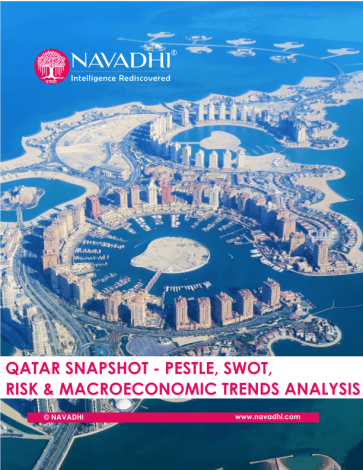



Qatar Snapshot - PESTLE, SWOT, Risk and Macroeconomic Analysis report is designed to provide in-depth information about Qatar including it’s PESTLE (political, economic, social, technological, legal and environmental), SWOT (Strengths, Weaknesses, Opportunities and Threats) and country risk analysis backed by macroeconomic data.
Qatar, officially, officially the State of Qatar, is a sovereign Arab emirate, located in Western Asia, which is occupied in the small Qatar Peninsula on the north-easterly coast of the much larger Arabian Peninsula. Its sole land border is with Saudi Arabia to the south, with the rest of its territory surrounded by the Persian Gulf.

Qatar is estimated to have population of 2.617 million in the year 2023 and expected to reach 2.514 million by 2027, decreasing at a CAGR of 1%.
Qatar’s real gross domestic product (GDP) was QAR 648.027 billion in 2020 and while recovering from the COVID-19 impact it increased by 1.57% to be around QAR 658.338 billion in 2021. It is further expected to increase by a CAGR of 2.8% and reach QAR 776.965 billion by 2027.
Qatar’s per capita GDP was USD 82,886.789 whereas purchasing power parity (PPP) based per capita GDP was USD 1,13,674.648 for the year 2022.
In 2022, Qatar government’s revenue was QAR 323.529 billion whereas the expenditure was QAR 222.641 billion. This resulted in Qatar government’s net lending / borrowing positive at QAR 100.888 billion in 2022 indicating that enough financial resources were made available by the Qatar government to boost economic growth.
The current account balance for Qatar was positive USD 46.87 billion for the year 2022 and is expected to further decrease at a CAGR of 14.74% and reach positive USD 21.121 billion by 2027. This positive current account balance indicates that Qatar will remain a net lender to rest of the world till 2027.
*If Applicable.